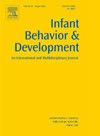Mother-infant physiological synchrony in the context of childbirth-related posttraumatic stress symptoms
IF 1.9
3区 心理学
Q3 PSYCHOLOGY, DEVELOPMENTAL
引用次数: 0
Abstract
Synchrony in mother-infant interactions is crucial for infant development. However, mother-infant physiological synchrony in the context of maternal childbirth-related posttraumatic stress symptoms (CB-PTSS) remains unknown. This pilot study aimed to investigate physiological synchrony within the context of CB-PTSS. Additionally, it investigated the association between mother-infant physiological synchrony and reciprocity. A total of 86 French or English-speaking mothers and their term infants participated in the study. Maternal CB-PTSS was assessed using the PTSD Checklist for DSM-5 (PCL-5), modified for childbirth. Mother-infant dyads were classified into three groups based on their responses to the PCL-5. During mother-infant interactions, physiological synchrony was measured using heart rate variability (HRV), while reciprocity was observed in video recordings. Cross-lagged analysis revealed distinct patterns of HRV fluctuations between mother-infant dyads: positive (mother and infant HRV fluctuated in the same direction) or negative (mother and infant HRV fluctuated in the opposite direction). To avoid canceling out potential effects by averaging the positive and negative correlation coefficients, we analyzed them separately. In positive dyads, maternal HRV led infant HRV by approximately two seconds. Conversely, in negative dyads, there was no significant lag or lead observed in either direction. Our analysis did not reveal a significant impact of CB-PTSS group classification on the physiological synchrony between mothers and their infants. Additionally, we found no significant relation between physiological synchrony and reciprocity within the dyads. We recommend that future studies with a similar focus should control for factors such as individual physiological regulation, maternal anxiety, and maternal depression to further explain these relationships.
分娩相关创伤后应激症状背景下的母婴生理同步性
母婴互动的同步性对婴儿发育至关重要。然而,母婴在分娩相关创伤后应激症状(CB-PTSS)中的生理同步性尚不清楚。本初步研究旨在探讨CB-PTSS背景下的生理同步性。此外,研究了母婴生理同步与互惠的关系。共有86名说法语或英语的母亲和她们的足月婴儿参与了这项研究。使用DSM-5 (PCL-5) PTSD检查表对产妇进行CB-PTSS评估,该检查表针对分娩进行了修改。根据母婴对PCL-5的反应,将母子二人组分为三组。在母婴互动过程中,使用心率变异性(HRV)测量生理同步性,同时通过录像观察互惠性。交叉滞后分析揭示了母婴间HRV波动的不同模式:阳性(母亲和婴儿HRV在同一方向波动)或阴性(母亲和婴儿HRV在相反方向波动)。为了避免通过平均正相关系数和负相关系数来抵消潜在的影响,我们分别对它们进行了分析。在阳性的二联体中,母亲的HRV比婴儿的HRV高大约2秒。相反,在负二对中,在任何方向上都没有观察到明显的滞后或领先。我们的分析并未显示CB-PTSS组分类对母婴生理同步性的显著影响。此外,我们发现生理同步性和互惠性之间没有显著的关系。我们建议未来的研究应以类似的重点控制个体生理调节、母亲焦虑和母亲抑郁等因素,以进一步解释这些关系。
本文章由计算机程序翻译,如有差异,请以英文原文为准。
求助全文
约1分钟内获得全文
求助全文
来源期刊

Infant Behavior & Development
PSYCHOLOGY, DEVELOPMENTAL-
CiteScore
4.10
自引率
4.80%
发文量
94
期刊介绍:
Infant Behavior & Development publishes empirical (fundamental and clinical), theoretical, methodological and review papers. Brief reports dealing with behavioral development during infancy (up to 3 years) will also be considered. Papers of an inter- and multidisciplinary nature, for example neuroscience, non-linear dynamics and modelling approaches, are particularly encouraged. Areas covered by the journal include cognitive development, emotional development, perception, perception-action coupling, motor development and socialisation.
 求助内容:
求助内容: 应助结果提醒方式:
应助结果提醒方式:


